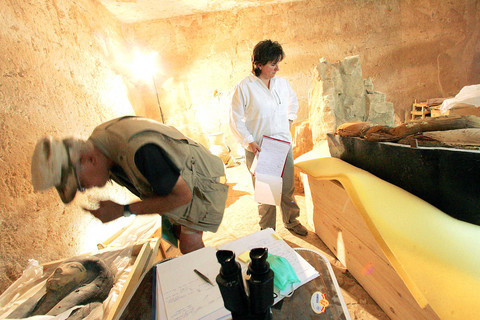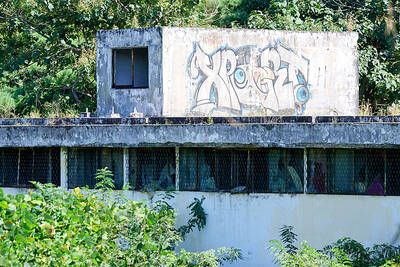It had been 84 years since a tomb was unearthed here in the scorching desert burial ground for pharaohs, and the hope, of course, was for mummies. What else could be inside the seven coffins, at the bottom of a shaft that until February had been sealed off from all but termites for more than three millenniums?
Very nice pillows, for starters.
"No idea, I'm sorry," Elsie van Rooij, an expert on ancient textiles, said, when asked why it was that some burial worker had stuffed five pillows into the child-size coffin she was examining.

PHOTO: NY TIMES NEWS SERVICE
Coffins usually hold bodies. She had never seen anything like it. Naturally, that pleased her.
"A tomb should be mysterious," she said.
After three months of long and painstaking work since the February discovery, with five of the coffins opened, no mummies have been found. So there is a chance that this is not a tomb at all, but rather a cache for used embalming materials.
But there is one big coffin left to open -- the most tantalizing one, sealed, wedged into the back of the space and supported by pillows at its head and feet, with the kind of care that could suggest that someone important is inside.
The US Egyptologists who are working here plan to open it, hoping not only for a mummy but to solve the many mysteries of the new find. They may also shatter a long-held belief that there is nothing important left to find in the Valley of the Kings.
"If it will be a mummy, it will be a big discovery," said Mansour Boraik, the Egyptian government's head of antiquities at Luxor.
The theory that there might be a mummy in the last coffin got a boost on May 24: A small gilded sarcophagus, of a quality that could suggest royalty, was found under the pillows in the small coffin she was examining.
If there is a mummy, Boraik has a best-case scenario of who it might be: Ankhesenpaaten, King Tutankhamen's widow. One of the few pieces of writing found at the bottom of the shaft, on a broken seal, is a part of her name.
"What happened to this widow, we don't know," he said.
Hopes aside, there has never been any suggestion that the new discovery, called KV-63, has anywhere near the significance of KV-62, the last tomb uncovered, in 1922. That one, famously, held the mummy of Tutankhamen and one of the greatest troves of Egyptian artifacts ever found. The valley had given up nothing major since.
The new find is only a few feet away from King Tut's. But it is just one small and unadorned room, at the bottom of a shaft that the US team, led by Otto Schaden, an American Egyptologist who leads a project with the University of Memphis, discovered last year.
He had been digging around some ancient workmen's huts near the tomb of the pharaoh Ay, the last king of the 18th dynasty and the life's work of Schaden. On the last day of the dig, in the last possible place, he came across what he now calls "an unusual situation."
"Lo and behold, there was a dark layer where there should have been bedrock," said Schaden, 68, who smokes a pipe, wears a goatee, has lots of pens in his dusty vest and so looks very satisfyingly like an Egyptologist.

LANDMARK CASE: ‘Every night we were dragged to US soldiers and sexually abused. Every week we were forced to undergo venereal disease tests,’ a victim said More than 100 South Korean women who were forced to work as prostitutes for US soldiers stationed in the country have filed a landmark lawsuit accusing Washington of abuse, their lawyers said yesterday. Historians and activists say tens of thousands of South Korean women worked for state-sanctioned brothels from the 1950s to 1980s, serving US troops stationed in country to protect the South from North Korea. In 2022, South Korea’s top court ruled that the government had illegally “established, managed and operated” such brothels for the US military, ordering it to pay about 120 plaintiffs compensation. Last week, 117 victims

China on Monday announced its first ever sanctions against an individual Japanese lawmaker, targeting China-born Hei Seki for “spreading fallacies” on issues such as Taiwan, Hong Kong and disputed islands, prompting a protest from Tokyo. Beijing has an ongoing spat with Tokyo over islands in the East China Sea claimed by both countries, and considers foreign criticism on sensitive political topics to be acts of interference. Seki, a naturalised Japanese citizen, “spread false information, colluded with Japanese anti-China forces, and wantonly attacked and smeared China”, foreign ministry spokesman Lin Jian told reporters on Monday. “For his own selfish interests, (Seki)

Argentine President Javier Milei on Sunday vowed to “accelerate” his libertarian reforms after a crushing defeat in Buenos Aires provincial elections. The 54-year-old economist has slashed public spending, dismissed tens of thousands of public employees and led a major deregulation drive since taking office in December 2023. He acknowledged his party’s “clear defeat” by the center-left Peronist movement in the elections to the legislature of Buenos Aires province, the country’s economic powerhouse. A deflated-sounding Milei admitted to unspecified “mistakes” which he vowed to “correct,” but said he would not be swayed “one millimeter” from his reform agenda. “We will deepen and accelerate it,” he

‘HYANGDO’: A South Korean lawmaker said there was no credible evidence to support rumors that Kim Jong-un has a son with a disability or who is studying abroad South Korea’s spy agency yesterday said that North Korean leader Kim Jong-un’s daughter, Kim Ju-ae, who last week accompanied him on a high-profile visit to Beijing, is understood to be his recognized successor. The teenager drew global attention when she made her first official overseas trip with her father, as he met with Chinese President Xi Jinping (習近平) and Russian President Vladimir Putin. Analysts have long seen her as Kim’s likely successor, although some have suggested she has an older brother who is being secretly groomed as the next leader. The South Korean National Intelligence Service (NIS) “assesses that she [Kim Ju-ae]